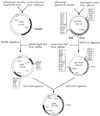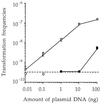Plant genome complexity may be a factor limiting in situ the transfer of transgenic plant genes to the phytopathogen Ralstonia solanacearum
- PMID: 10966449
- PMCID: PMC92279
- DOI: 10.1128/AEM.66.9.4161-4167.2000
Plant genome complexity may be a factor limiting in situ the transfer of transgenic plant genes to the phytopathogen Ralstonia solanacearum
Abstract
The development of natural competence by bacteria in situ is considered one of the main factors limiting transformation-mediated gene exchanges in the environment. Ralstonia solanacearum is a plant pathogen that is also a naturally transformable bacterium that can develop the competence state during infection of its host. We have attempted to determine whether this bacterium could become the recipient of plant genes. We initially demonstrated that plant DNA was released close to the infecting bacteria. We constructed and tested various combinations of transgenic plants and recipient bacteria to show that the effectiveness of such transfers was directly related to the ratio of the complexity of the plant genome to the number of copies of the transgene.
Figures




Similar articles
-
Intergeneric transfer of chromosomal and conjugative plasmid genes between Ralstonia solanacearum and Acinetobacter sp. BD413.Mol Plant Microbe Interact. 2003 Jan;16(1):74-82. doi: 10.1094/MPMI.2003.16.1.74. Mol Plant Microbe Interact. 2003. PMID: 12580284
-
Detection of potential transgenic plant DNA recipients among soil bacteria.Environ Biosafety Res. 2007 Jan-Jun;6(1-2):71-83. doi: 10.1051/ebr:2007036. Epub 2007 Oct 26. Environ Biosafety Res. 2007. PMID: 17961481
-
Ralstonia solanacearum requires PopS, an ancient AvrE-family effector, for virulence and To overcome salicylic acid-mediated defenses during tomato pathogenesis.mBio. 2013 Nov 26;4(6):e00875-13. doi: 10.1128/mBio.00875-13. mBio. 2013. PMID: 24281716 Free PMC article.
-
Ralstonia solanacearum, a widespread bacterial plant pathogen in the post-genomic era.Mol Plant Pathol. 2013 Sep;14(7):651-62. doi: 10.1111/mpp.12038. Epub 2013 May 30. Mol Plant Pathol. 2013. PMID: 23718203 Free PMC article. Review.
-
Recent advances in development of marker-free transgenic plants: regulation and biosafety concern.J Biosci. 2012 Mar;37(1):167-97. doi: 10.1007/s12038-012-9187-5. J Biosci. 2012. PMID: 22357214 Review.
Cited by
-
Could DNA uptake be a side effect of bacterial adhesion and twitching motility?Arch Microbiol. 2013 Apr;195(4):279-89. doi: 10.1007/s00203-013-0870-1. Epub 2013 Feb 5. Arch Microbiol. 2013. PMID: 23381940 Free PMC article. Review.
-
Next-generation marker-free transplastomic plants: engineering the chloroplast genome without integration of marker genes in Solanum tuberosum (potato).Plant Cell Rep. 2024 Nov 22;43(12):290. doi: 10.1007/s00299-024-03375-9. Plant Cell Rep. 2024. PMID: 39578272
-
In situ transfer of antibiotic resistance genes from transgenic (transplastomic) tobacco plants to bacteria.Appl Environ Microbiol. 2002 Jul;68(7):3345-51. doi: 10.1128/AEM.68.7.3345-3351.2002. Appl Environ Microbiol. 2002. PMID: 12089013 Free PMC article.
-
Degradation and transformability of DNA from transgenic leaves.Appl Environ Microbiol. 2003 Jan;69(1):673-8. doi: 10.1128/AEM.69.1.673-678.2003. Appl Environ Microbiol. 2003. PMID: 12514059 Free PMC article.
-
Plant-specific promoter sequences carry elements that are recognised by the eubacterial transcription machinery.Transgenic Res. 2002 Jun;11(3):291-303. doi: 10.1023/a:1015620016472. Transgenic Res. 2002. PMID: 12113461
References
-
- Béclin C, Charlot F, Botton E, Jouanin L, Doré C. Potential use of the aux2 gene from Agrobacterium rhizogenes as a conditional negative marker in transgenic cabbage. Transgenic Res. 1993;2:48–55.
-
- Bertolla F, Brito B, Frostegard A, Nesme X, Simonet P. During infection of its host, the plant pathogen Ralstonia solanacearum naturally develops a state of competence and exchanges genetic material. Mol Plant-Microbe Interact. 1999;12:467–472.
-
- Bertolla F, Simonet P. Horizontal gene transfers in the environment: natural transformation as a putative process for gene transfers between transgenic plants and soil micro-organisms. Res Microbiol. 1999;150:1–10. - PubMed
Publication types
MeSH terms
LinkOut - more resources
Full Text Sources

